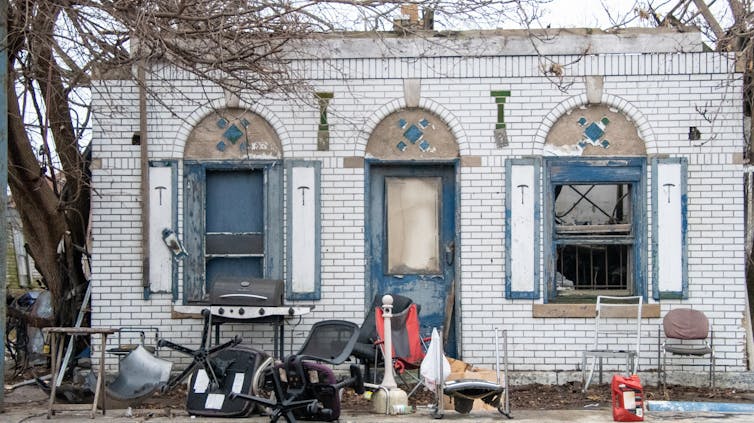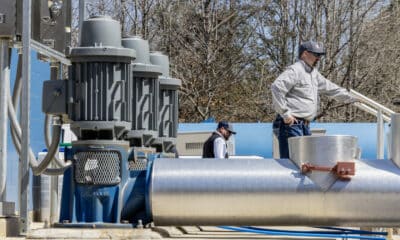
Julio Cesar Aguilar/AFP via Getty Images
Bedassa Tadesse, University of Minnesota Duluth
Get ready to pay more for avocados, maple syrup and – well – almost everything.
The U.S. officially imposed new 25% tariffs on Canada and Mexico on March 4, 2025, following through on a long-delayed pledge from President Donald Trump. American consumers and businesses are now bracing for higher costs and potential supply disruptions.
Although tariffs, or taxes on imports, are a pillar of Trump’s economic policy, the move still surprised many observers, since Mexico and Canada are among the U.S.’s traditional allies and top trading partners. The administration further rattled global supply chains by doubling existing tariffs on Chinese goods to 20%.
As an economist who studies global trade, I wanted to know how the 25% import duties on Canada and Mexico would affect different parts of the country. So I conducted a state-by-state impact analysis.
What I found is alarming: The U.S. economy could face an annual loss of US$109.23 billion. This shortfall would mean rising costs of everyday goods for American families and would disproportionately affect certain states. My analysis focused exclusively on the effects of U.S. tariffs, so it didn’t take retaliation from Canada or Mexico into account. If it did, the losses would be even greater.
Unequal burdens for states, higher prices for families
Imagine your grocery bill surging by 17.5% to 25%, car parts costing hundreds of dollars more, and your favorite local restaurant raising prices as imported ingredients become unaffordable. Because tariffs drive up consumer prices, these scenarios, or others like them, will soon become reality across the U.S.
But not all Americans will be affected equally, I found. States that are deeply connected to North American supply chains will suffer the biggest economic blows. Texas, with its strong trade ties to Mexico and key role in energy, would lose $15.3 billion. California’s diverse economy would take a $10.2 billion hit. Michigan, heavily reliant on auto manufacturing, would face a $6.2 billion blow – over 1% of its gross domestic product.
The biggest losers from the policy on a per-capita basis would be smaller, trade-dependent states that lack the flexibility to absorb such a shock. New Mexico, Kentucky and Indiana would be among the hardest hit, with projected GDP losses ranging from 1.12% to 1.48%. These states rely heavily on manufacturing and specialized industries, making them particularly vulnerable to rising costs and supply chain disruptions.
Take New Mexico. While it may not experience the largest total economic loss, it would bear the highest per-person burden. That $1.73 billion hit to its economy would translate to $822 for every resident – a devastating blow in a state where incomes are already below the national average.
Indeed, the likely effects of tariffs will be felt especially hard by American families. For example, a family of four in New Mexico would see an estimated $3,288 additional annual costs, equivalent to three months of grocery bills or an entire year’s utility expenses. Families in Kentucky and Indiana would also bear heavy financial burdens, paying an extra $3,120 and $2,836, respectively. Even in wealthier states such as Texas, the added annual costs would reach over $2,000 per household.
For middle- and lower-income families, these aren’t trivial costs. They represent difficult trade-offs, forcing households to cut back on essentials, delay major purchases or dip into savings to make ends meet.

Geoff Robins/AFP via Getty Images
Where industry will face a tough hit
Perhaps no industry would suffer more than the auto sector, particularly in states such as Michigan, Indiana and Kentucky. These regions rely on a highly integrated North American supply chain, where components cross borders multiple times before a final product reaches consumers. Tariffs would disrupt this delicate balance, leading to price increases, reduced production and job losses.
My conservative estimate shows that such disruptions could cost the industry approximately $28.2 billion, putting around 680,000 jobs at risk across manufacturing, parts production and sales operations. And the ripple effects would extend beyond automakers to suppliers, dealerships and local economies.
But the pain wouldn’t stop there. Manufacturing, which plays a critical role in 17 of the top 20 states most affected by tariffs, would also face rising costs and shrinking profit margins. The agricultural sector – vital in at least 10 states – would endure higher input costs and potential retaliatory tariffs from Mexico and Canada. Past trade disputes have shown that American farmers often bear the brunt of such policies, with lost export markets and declining revenues.
During the U.S.-China trade war of 2018-2019, for example, American farmers suffered over $27 billion in losses, with soybean exports dropping by 71% and states such as Iowa, Illinois and Kansas losing billions in GDP. The federal government paid affected farmers more than $23 billion to offset these losses. Similar – and possibly worse – challenges loom now.
Retaliation from Mexico and Canada could deal a heavy blow to agricultural exports – including corn, beef and dairy – that anchor local economies, especially in Iowa, Nebraska and Wisconsin. Both countries have threatened countermeasures targeting key U.S. exports, raising concerns among farmers and agribusinesses. Retaliatory tariffs could shrink profit margins, further disrupt supply chains, and create uncertainty for producers relying on these markets.
Looking at the bigger picture
The new Trump tariff regime represents a fundamental shift in how the U.S. engages with its closest economic partners. While ostensibly meant to strengthen American industry, the tariffs on offer have serious side effects that will likely cause widespread disruptions for businesses, consumers and entire state economies.
Trade isn’t just about numbers on a spreadsheet. It’s about real people, real businesses and the intricate economic fabric that connects the nation. Changes to this system can come at a high price. Safeguarding American jobs and ensuring economic stability entails recognizing the realities of global trade and considering the trade-offs of instituting new policies.
While tariffs are one method of disrupting the status quo, they are far from the only way. Indeed, reform is also possible through targeted policies – including negotiated trade agreements, investment incentives and workforce development programs – that address trade concerns without altering deeply integrated supply chains.![]()
Bedassa Tadesse, Professor of Economics, University of Minnesota Duluth
This article is republished from The Conversation under a Creative Commons license. Read the original article.
















































